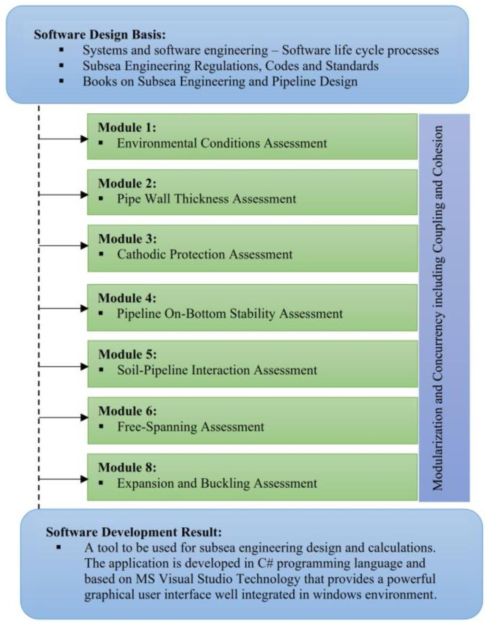Subsea Engineering Suite
JG Consultant & Ocean Engineering Services is engaged in development of standalone small scale software applications, that also is including
development of a software application for subsea pipeline engineering and design.
The pipeline design optimization can be defined as a process of searching for a modified design that optimizes the pipeline performance, i.e. the
service life, or integrity, while satisfying some given constraints.
While spreadsheets might be useful for simple calculations, they have their limitations when it comes to advanced engineering mathematics.
Many independent spreadsheet-based calculations covering each design code in turn, can sometimes result in poor communication, causing
critical errors that can be difficult to trace or get audited.
Current scope is a modular application that is divided into a set of loosely coupled functional units (named modules) covering each design code
independently, that can be integrated into a larger application. A module is a logical collection of functionality and resources. When
developing the application in a modularized fashion, the application is structured into separate engineering modules that can be separately
developed, tested, verified, deployed, and integrated into the application.
It is a standard calculation tool embedded in a software application developed in .NET C# language with MS Visual Studio Technology that provides
a powerful graphical user interface well integrated in windows environment.
Code Check - Offshore Design Codes
We have developed a software application for subsea pipeline engineering and design. By adding the relevant subsea design code of practice functionality
to the software, it is possible to producing a suite of coupled reliability analysis and design programs for the subsea Oil & Gas industry.
A modularization technique is used to divide the software system into multiple discrete and independent modules based on design codes.
Development of software for subsea engineering design and analysis when considering subsea pipeline design, is to a large extent based on the offshore
industry regulations, rules and standards.
While spreadsheets might be useful for simple calculations, they have their limitations when it comes to advanced engineering mathematics.
Spreadsheet-based calculations can result in hours spent on idle tasks, poor communication among team members, and critical errors that can be
neither traced nor audited.
This subsea engineering software is a collection of program modules, processes and information that allow users to calculate and depict multifaceted
engineering problems and to save calculations for future use. The user can calculate values for dozens of variables, including mechanical design for
different purposes and fluid flow, pressure, design load, etc.
The Figure below is a flowchart representing a process for dealing with subsea software design in a modular approach.

To develop this application Microsoft Visual Studio has been used as an integrated development environment (IDE), including a code editor
as well as a designer for building graphical user interface (GUI) applications using Windows Forms (WinForms) as software development
platform. A GUI class library is included as a part of Microsoft .NET Framework acting as a platform for the user interface tier in
a multi-tier solution. The GUI is what the user sees on the screen, including formatted data and system navigation menus. It is
designed to operate inside the WinForms.
Exception handling is provided by C# programming language constructs. In general, an exception breaks the normal flow of execution and
executes a pre-registered exception handler.
For input validation to pre-emptively filter exceptional cases, error checking is used as an alternative approach to exception handling,
which maintains normal program flow with later explicit checks for contingencies reported using special return values or some
auxiliary global variable.
During quality control and testing the application is checked whether the application is fit for its intended use, included error
checking. The activities included in the quality check and testing are in accordance with international standard for software
lifecycle processes. It aims to be the standard that defines all the tasks required for developing and maintaining software.
The objective of the Verification Document is to provide an independent verification of the implementation of the basic models and
main principles described in the offshore design codes presented above. This is performed by presenting calculation examples
covering the methods and comparing the calculation results with other validated output.
A guide to the use of this subsea engineering software application will be found in the User’s Manual.
The objective of the User’s Manual is to provide a brief introduction and the information necessary for the user to effectively use the
program software.
Including a Method for Free-Spanning Pipeline Analysis
The scope of this software application is to automate a method for design and analysis of free-spanning pipelines. It is implemented
in an application for assessment of dynamic response of free spanning pipelines subjected to combined wave and current loading.
The premises are based on application development within pipeline free span evaluation in a software development project.
The fatigue damage is calculated and integrated over all selected directions, corresponding sea-states and current. Fatigue life
is calculated for the in-line response model, in-line force model and the cross-flow response model.
In summary, this application calculates stresses and associated fatigue life due to:
- Combined direct wave action and in-line vortex induced vibrations (VIV).
- Cross-Flow VIV based on environmental description, i.e., integrated over all selected directions, corresponding long-term
sea-states and current.
- Free-spanning pipeline scenario considering water depth, free-span geometry, soil conditions, etc.
- Pipeline material characteristics, geometrical aspects, SN-curve data, etc.
- Checks of peak stress and equivalent stress due to combined static and dynamic actions in accordance with ultimate limit
state (ULS) design.